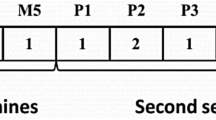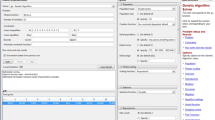Abstract
Manufacturing cell formation is a useful strategy in batch type production industries for enhancing productivity and flexibility. The basic idea rests on grouping the parts into part families and the machines into machine cells. Most of the literature used zero-one incidence matrix representing the part visiting a particular machine as one and zero otherwise. The output is generated in the form of block diagonal structure where each block represents a machine cell and a part family. In such models real life production factors such as operation time and sequence of operations are not accounted for. In this paper, the operational time of the parts required for processing in the machines is considered. It is attempted to develop an algorithm using genetic algorithm (GA) with a combined objective of minimizing the total cell load variation and the exceptional elements. The results are compared with the solutions obtained from K-means clustering and C-linkage clustering algorithms.
Similar content being viewed by others
References
Ranson GM (1972) Group technology: a foundation for better total company operation. McGraw-Hill, London
Boctor FF (1991) A linear formulation of the machine-part cell formation problem. Int J Prod Res 29:343–346
Venugopal V, Narendran TT (1992) Cell formation in manufacturing systems through simulated annealing. Eur J Oper Res 63:409–422
Kao Y, Moon YB (1991) A unified group technology implementation using the back propagation learning rule of neural networks. Comps & Ind Engg 20(4):425–437
Jayakrishnan Nair G, Narendran TT (1999) ACCORD: a bicriterion algorithm for cell formation using ordinal and ratio-level data. Int J Prod Res 37(3):539–556
Goncalves, JF, Resende, MGC (2002) A hybrid genetic algorithm in cell formation problems. AT&T Labs Research Technical Report TD-5FE6RN, AT&T Labs Research, Florham Park, NJ 07932 USA
Muruganandam A, Prabhaharan G, Asokan·P, Baskaran V (2005) A memetic algorithm approach to the cell formation problem. Int J Adv Manuf Technol 25:988–997
Venugopal V, Narendran TT (1992) A genetic algorithm approach to the machine component grouping problem with multiple objectives. Comps & Ind Engg 22:469–480
George AP, Rajendran C, Ghosh S (2003) An analytical-iterative clustering algorithm for cell formation in cellular manufacturing systems with ordinal-level and ratio-level data. Int J Adv Mfg Tech 22:125–133
Yasuda K, Hu L, Yin Y (2005) A grouping genetic algorithm for the multi-objective cell formation problem. Int J Prod Res 43(4):829–853
Holland JH (1975) Adaptation in natural and artificial systems. The University of Michigan Press, Ann Arbor, Michigan
Goldberg DE (1989) Genetic algorithms in search, optimization and machine learning. Addison-Wesley, Reading, MA, pp 28–150
Michalewicz Z (1996) Genetic algorithms + data structures = evolution programs. Springer, Berlin Heidelberg New York, pp 115–263
Zolfaghari S, Liang M (2003) A new genetic algorithm for the machine/part grouping problem involving processing times and lot sizes. Comps & Ind Engg 45:713–731
Chandrasekharan MP, Rajagopalan R (1986a) An ideal seed non-hierarchical clustering algorithm for cellular manufacturing. Int J Prod Res 24:451–464
Kumar KR, Chandrasekaran MP (1990) Grouping efficacy: a quantitative criterion for goodness of block diagonal forms of binary matrices in group technology. Int J Prod Res 28(2):233–243
Prabhakaran G, Janakiraman TN, Sachithanandam M (2002) Manufacturing data based combined dissimilarity coefficient for machine cell formation. Int J Adv Manuf Technol 19:889–897
Author information
Authors and Affiliations
Corresponding author
Rights and permissions
About this article
Cite this article
Mahapatra, S.S., Pandian, R.S. Genetic cell formation using ratio level data in cellular manufacturing systems. Int J Adv Manuf Technol 38, 630–640 (2008). https://doi.org/10.1007/s00170-007-1029-5
Received:
Accepted:
Published:
Issue Date:
DOI: https://doi.org/10.1007/s00170-007-1029-5




